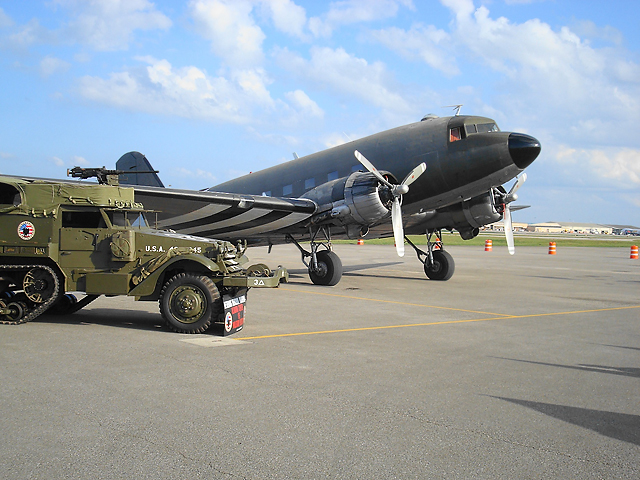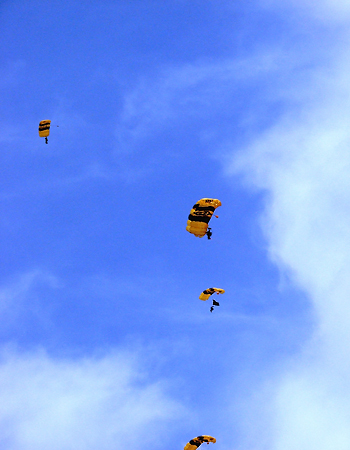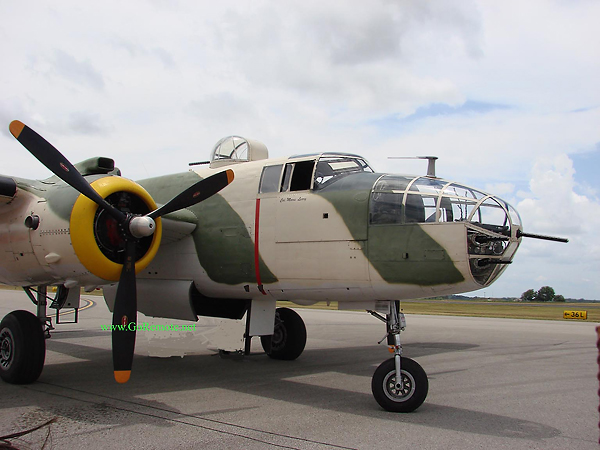 |
 |

Go Remote Adventures' News and Views |
|||||||||||||||||||||||
THE EMMY® AWARD GALA About five hundred professional film and media folks were seated at tables at the Grand Renaissance in St. Louis for the Mid America EMMY® awards.
I was honored
to be on producer Josh Baxter’s team, to have had a part in the already
award winning production AND for us to be nominated in the category
(historic documentary film) among the keen competition of those who applied
-- because “Injury Slight, Please Advise” was accurate in every detail. The
nomination really was an honor and we’re very happy to have been there and
to be recognized. There were lots of “big guys” at the adjacent tables –
including TV networks with series specials and others… $$$ … like the media
guys from the Kansas City Chiefs (you may have heard of them), at the next
table.
|
|||||||||||||||||||||||
|
EMMY® Nominated !
To view the original one minute "Stone
Age" trailer -- Click here:
To view the "new 30 second "Fly By"
trailer" -- Click here:
To Purchase your full length feature DVD
in HD of "Injury Slight, Please Advise" today, Click here: |
|||||||||||||||||||||||
|
|
|||||||||||||||||||||||
|
|
|||||||||||||||||||||||
|
RETURNING FROM AUSTRALIAN RESEARCH on this missing crew. The crew of the Qantas A380, Airbus – acted promptly on the fight deck with various emergency procedures after an engine blew. Although it hasn’t been given much news coverage here in the States, the Sydney Herald Sun newspaper disclosed some details in advance of the official investigation. Listed below are a few of the 18 things listed as going wrong….. The crew could not shutdown the No. 1 engine using the fire switch. As a result the engine's fire extinguishers could not be deployed. Captain Richard de Crespigny, first officer Matt Hicks and Mark Johnson, the second officer, could not jettison the volume of fuel required for a safe emergency landing. With more than 80 tonnes of highly volatile jet kerosene still in the 11 tanks -- two of which were leaking - they made an overweight and high speed approach to Changi Airport. Without full hydraulics the spoilers - the hinged flaps on the front of the wings - could not be fully deployed to slow the jet. The crew also had to rely on gravity for the undercarriage to drop and lock into place. On landing they had no anti-skid brakes and could rely on only one engine for reverse thrust - needing all of the 4km runway at Changi to bring the jet to a stop. Since our flight was one of six Qantas A380’s, and we were already in the air to LAX, I missed being the guest on Qantas for added days in Australia when they grounded their fleet. After our uneventful landing our LAX Airbus was going to be held for a quick inspection – but … two weeks later they are still grounded with the engine problems that were identified. Sometimes long, boring flights are a good thing. After all, how exciting can records research be in 3 differing Australian locations? Ans. Pretty exciting if you locate important files….. and when your A380 holds together on your return flight-- you don’t mind missing added excitement.
|
|||||||||||||||||||||||
|
|
| Go Remote, Inc. Adventures Shares Film Award |
|
Arion Pictures, LLC of
Hot Springs, AR and Go Remote, Inc. Adventures …Not Vacations, of
Madison, AL were recently notified they have been recognized with a
national film award for their production of Injury Slight, Please
Advise. The film is the accurate account and reenactment of a WWII
fighter pilot’s survival in the wilds of New Guinea. The plane wreck is
largely in tact in a very remote swamp and has been seen by fewer than
10 non natives since WWII. Steve Cushman, of Go Remote Adventures, was
featured in the film and served as guide and the logistics coordinator
for the filming that included hiking miles into the jungles of New
Guinea to film the rediscovered P-38 fighter. |
| Lost New Guinea
Battlefield Found (story and photos) http://news.blogs.cnn.com/2010/06/07/lost-wwii-battlefield-found-war-dead-included/
|
| Australian archives hold the records for post war searches in New Guinea | |||||
|
|||||
|
Why Australian Research? The New Guinea research for the missing American WWII bomber crew, known to have survived their forced landing, is explained in more detail on the “Papua New Guinea” tab (above) of this page and on “News/Views” ( also above). “Why research a lost American crew in Australia?” is a logical question. The answer is that Australia was assigned the post war Allied task of investigating war crimes and searching for all aircrews lost in New Guinea. They retain the records on same, at times attempting to identify if a located crash site was an American or an Australian plane/crew. The U.S. post war forces searched other battle areas of the vast Pacific Theater. Australian records include the sworn witness testimony of various investigations and trials related to war crimes and the fate of Allied POW’s and missing air crews. |
|||||
| "Surviving Hell, A POW's Journey" |
|
My basis of comparison for “normal” as a fighter pilot is that one of my life’s very best friends was also a fighter pilot, the late Larry Counts, so I know it’s really hard to tell if any of them are what the military, retired military or even civilians call “normal” people. Col Leo seems “normal” enough… friendly, soft spoken, cheerful and he has a charming wife, but he isn’t normal. I suspected he wasn’t normal when I learned some of his background. After a bit of time around him – I started to think he was … “normal,” aside from some of his physical scars visible in summer Alabama attire. He makes light hearted reference to fun things like “going fast” and of taking care not to say the word “cockroach” aloud during a party at the bar (It’s a bar game all true fighter pilots “perform” – don’t say it aloud in a group of them with spirits) and he makes reference to good days when you can see door knobs on the inside. He asks you questions. But I learned he isn’t normal, after I heard him speak more formally. He spoke mostly about fellow POW’s and about life. Nothing about winning America’s highest military award but…he can bring tears to your eyes…talking about life, making his point about the service of others … and, indirectly, about his own incredible service to this nation. Col Leo Thorsness proves there are heroes among us. If you aren’t a liberal wimp who thinks: A. there is no evil in the world. B. you can just “talk to’em” and C. you don’t realize there are those who endure to serve this nation - BUY his book. On second thought, maybe the liberal wimps need to read it most of all. Checkout Col T's new page - done by his friends - and order his Great book. www.leothorsness.com
|
|
New Guinea Native Storyboard The native storyboard above was done by a native tribesman on the north coast of New Guinea. New Guinea is known to have over 700 different tribal languages and few of them are written. A common factor among the remote native tribes is the strong tradition of verbal history or story telling to “record” significant events, tribal battles or other incidents that have taken place in the family or tribe. These carved storyboards are a means of recording events. The carvings are sometimes on other items and I once admired very old, hardwood carvings on the sides of log drums in a native tribal longhouse that a museum would love to display. One other thing about the storyboards is that they work best as an outline reminder of story elements … when you already Know the story. Our great and accommodating dive operator hosts, Lesley and Tim, had this native storyboard made for us when we were in Papua New Guinea filming the WWII wrecked P-38 for “Injury Slight, please advise ”. You may already be aware that producer Josh Baxter’s film title originated from the brief message sent weeks later by the WWII pilot following his crash and escape from natives after shooting a tribal leader with his .45 to avoid becoming dinner. It is an incredible survival account. During our remote jungle trek in to the P-38 wreck site we shot an additional Hi Def video interview with a native who had been a boy in the village near the WWII crash site. The amazing accuracy of the verbal tribal history tradition became apparent when the elderly native told the story with details that matched EXACTLY with what the surviving pilot had recounted. (Both Josh and I had made it a point to follow the guidance of an anthropologist on the area and pretended not to know the pilot or the story. We did not want to contaminate the story, and we did not forget the pilot had almost been…. dinner. ) I would argue that parts of New Guinea continue to be the wildest places in the world. Tribal wars, at times with bows and arrows, continue to be fought over important things, like stolen pigs, gardens or even …women. Almost 2 out of 3 we would not, or not often, do in the “civilized” world. Even our translator was surprised when the native’s story included his comments, … and they found his boots, “like his” – he said, pointing to my hiking boots as we shot the interview in the rocks and sand of a river’s edge. We knew the pilot has removed his boots in hope of making less noise as he was chased during his escape from the natives. It was but one aspect of the verbal history that confirmed the details of the pilot’s escape and the location. (To learn the added details, view full length documentary, “Injury Slight…Please Advise”.) The storyboard shows, at upper left, not just an airplane, but a twin engine, twinboom square tailed P-38 fighter, our request of that detail was followed by the native carver. It was shown flying above native huts, then crashing near the river into trees and grass. Note the second image of the P-38 fighter, to the right of the first image, is into the trees and has a broken right propeller, thus a crashed plane. The American “soldier” with the helmet goes near the river, with fish, and makes initial contact with the native tribe. He later contacts the Australians that are depicted with helmets that have cap bills – an effort lost in the translation that Australians wore cowboy style bush hats with turned up brims… Oh well – close enough that we “got it”. Later still, out of view in the photo, he goes to a western style “box” house as symbol of his return “home”. Conveniently, not included in the storyboard, is the part where the pilot was jumped by the natives and forced to shoot his way out at close range with his .45. Initially chased/tracked into the jungle and surviving for weeks. Although there is substantially more to the story … we got it from the tribal view and despite the native carver’s distance from the crash site and chase region… it is politically correct and the natives do not lose face...or tribesmen. More information on Baxter’s production made in close collaboration with the ace pilot who is the featured character of the WWII documentary is on the “Injury Slight” page at www.injuryslight.com. Go Remote
runs adventures… This storyboard account is just one aspect of the unique
experiences and memories that Go Remote adventures offer. Don’t take
another “everyone’s been there” vacation. Go Remote for a real adventure.
(Some adventure
applications require outdoor skills, but most require only good health and
an adventurous spirit.)
|


A Golden Knight with the U.S. Army lands near the
Blue Angels at the Huntsville, AL air show.
|
|
 |
|
Army Parachute Team, The
Golden Knights - |
|
 |
| B-25, WWII warbird |
 |
 |
| AH-64D, (Apache) with M230, (machine gun) Hellfire and Hyra 70 (missiles/rockets); Three target acquisition systems - approx $18 mil ... without munitions. | |
|
|
|
The newest CH47 "F" Model |
|
|
|
U.S. Navy Blue Angels
Demonstration Flight Team |
|
|
Don't take another "Everybody's been there" vacation
Steve Cushman, President and Adventurer